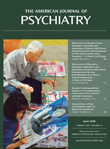Factors Affecting the Diagnosis and Prediction of PTSD Symptomatology in Children and Adolescents
Abstract
Objective: In a cohort that spanned all of childhood and suffered equivalent types of traumas, the authors examined diagnostic validity and risk factors for posttraumatic stress disorder (PTSD). For older children, parent-child agreement was investigated. Method: Sixty-two children ages 0–18 years who were hospitalized with injuries were assessed 2 months later for PTSD. Mothers were interviewed, and concurrent interviews were conducted with 24 adolescents. Results: Children did not attain the DSM-IV threshold of three criterion C items until age 7. The 0–6-year-old group had significantly fewer criterion C symptoms (mean=0.43) than the 12–18-year-olds (mean=1.17). The impact of altering thresholds for criteria C and D was examined. Older children reported symptoms meeting criterion B significantly more often (79.2%) than parents (45.8%). Combined parent-child reports yielded significantly more symptoms and higher rates for criteria B, C, and D (almost a twofold increase) and for the overall diagnosis (37.5%) than parent report alone (4.2%). This 8.9-fold increase in diagnosis from combined reports suggests that the diagnostic rates for children who cannot make self-reports may greatly underestimate the true numbers. The interaction between pretrauma externalizing behavior and witnessing a threat to a caregiver had a significant effect on the total number of PTSD symptoms. Conclusions: These findings provide additional support for lowering the requirement of three criterion C symptoms for preschool children and raise questions about the appropriateness of this threshold for prepubertal children. The validity of studies that do not assess symptoms with combined parent and child reports is limited.



